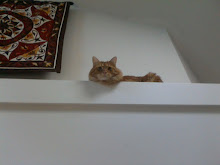 Infantry Regiments #1 Sleibnitz and #2 von Wöhl, led by the Leibgarde Grenadiers, on their first maneuvers of the New Year, with the Blaueberge in the background.
Infantry Regiments #1 Sleibnitz and #2 von Wöhl, led by the Leibgarde Grenadiers, on their first maneuvers of the New Year, with the Blaueberge in the background.  The Bishop of Guggenheim's Regiment of Horse on maneuvers.
The Bishop of Guggenheim's Regiment of Horse on maneuvers. Here are a couple of pictures of the growing might of the Grand Duchy of Hetzenberg. Half of the First Infantry Brigade is now complete, along with half of the Guard Cavalry Brigade in the shape of the Bishop's Horse. The Leibgarde Brigade is represented by the Grenadier regiment.
*
The Guard Infantry Brigade will be completed with the addition of the two Leib Fusilier regiments, a jäger battalion and an artillery battery.
*
The First Brigade will be completed by Infantry regiments #3 Bräbenachel and #4 von Kranke, a jäger battalion and an artillery battery.
*
Sharp-eyed observers will notice the guidon of the Bishop's Horse is larger than would normally be carried by cavalry, but I prefer the larger design as it's more visible.





9 comments:
Happy Weekend AJ,
Wow! Your troops are great looking, and it's impressive how quickly you have managed to assemble your units and paint them. Your standards and guidons help to make for a visually rich display of your recent work. Keep up the lovely work.
Best Regards,
Stokes
Eye candy at its best!
Compliments,
Jean-Louis
"a jäger battalion"?
I remember you toyed with the idea but... what will it look like?
Regards,
Jean-Louis
Thank you for your kind comments, gentlemen. Jean-Louis, your links to those figures in a previous comment are very useful. I can see the designs featuring somewhere in the Hetzenberg army.
I have obtained a small number of Dixon's Miniature British SYW light infantry in the "jockey cap" style headgear, which I'm contemplating painting up as line jager. Under the Shako rules light infantry skirmisher screens feature 8-12 figures, and the units themselves tend to dissolve fairly quickly during combat.
I also prefer all of my flags a bit larger than historically they would have been.
-- Jeff
AJ,
"jockey cap" = with a peak?
It's 200% personal, but for me I dislike headgears with peak in 'tricorn' setting - they remind me too much of shakos and other typically 19th C. military headgears, thus I resent them as "out of character".
I prefer to 'vizualize' such headgears with the peak raised vertically, as the front plate of a mitre: thus a "jockey cap" would look rather like the Austrian Feld Jägers's leather casquet (with a lower front piece).
Maybe, historically, that's how some early British light companies / squadrons obtained the front piece of their 'Ancient Roman'-like helmet?
I prefer well designed and well painted flags to be 'too large', and badly done ones to be 'too small'! Thus for me the guidon of the Bishop's Horse is of perfect size.
Compliments,
Jean-Louis
Looking good, I like to have larger flags too
-- Allan
Since I don't think anyone else has asked, what method are you using for making your standards?
I design the standards using the basic Paint program on my PC, refine them using the Microsoft PictureIt and print them off. The colors can fade quite quickly so I use them as a basic template for acrylic paints, attaching them to brass rod and then to the figures.
Post a Comment